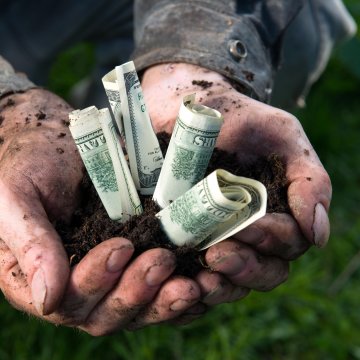Plant infections can now be detected in our crops before they're even visible.
The Secrets of High-Profit Farmers

Fresh data coming out of University of Minnesota’s FINBIN, often touted as the largest farm financial database available, summarizes actual farm data from thousands of farms and is updated annually. FINBIN analysts were asked to share what factors unite the top 20% of producers. What do they do that separates them from other farmers?
“They’re not doing one thing amazing,” says Katherine Wilts Johnson, Extension Economist with U of Minn. “Rather, they’re doing everything pretty well, and they work on doing everything just a little bit better.”
There are some specific practices that put some growers ahead of the pack. For example, high-profit farms tend to shop around, take early bird discounts, work regularly on their marketing plan, and focus on their working capital.
Cost control, in particular, is important to high-profit producers. They manage costs both on the farm and for family living.
That is particularly obvious when looking at machinery cost per acre. FINBIN data from 2022 shows that the top 20% invest around $608 per acre in total equipment costs, while the bottom 20% invest $716 – a more than $100-per-acre difference.
There also appears to be a correlation among all farms between profitable years and family living expenses. FINBIN data shows that family living expenses initially peaked in 2013-14 before slightly declining and leveling off for the next several years. Then, living expenses started to crest again in 2021 and reached a record $74,201 in 2022.
“If profits begin to dry up in 2024, it’s likely that the high-profit producers will be the first to make prudent cuts,” Johnson says. “What we find time and time again is that the high-profit group is really in charge of their spending. They really know when and where to tighten their belts.”
More productive
It’s probably no surprise that high-profit farms are also able to produce more bushels per acre. FINBIN data from 2020-22 shows that the highest profit farms saw corn yields average 216 bushels per acre (bpa), 61 bpa better than the lowest profit farms. Average soybean yields came in at 64 bpa (+29) and average wheat yields were 63 bpa (+16).
Here are some additional characteristic differences between the top 20% and the bottom 20% gleaned from the latest FINBIN data:

The big differences among bottom, middle and top growers can be jaw-dropping in a year like 2022. Consider farms with gross revenue of more than $2 million. The net median income for these larger operations averaged an impressive $786,918. However, low-profit farms only made an average of $217,605 – less than half of the total average. And high-profit farms more than doubled the median, with an average of $1,893,602.
That result wasn’t an anomaly, either. In 2013, another relatively “good” year in terms of farm income, the average large operation made $221,513, while low-profit farms averaged losses of $157,551 and high-profit farms averaged gains of $765,541.
“One other thing worth noting – the farms generating the highest levels of profit aren’t necessarily the largest operations,” Johnson says. “Bigger isn’t always better. There’s always more to the picture.”
EDITOR’S TAKE:
This article provides very meaningful insight about the profitability levels of various farms. The data also reveals why they are more profitable – efficiency, doing things better. Managing a farm/ranch demands several skill-sets and a true penchant for continual learning and improvement. It is amazing to quantify the differences between high and low performers. Also notable, level of profit doesn’t always correlate to size of operation. In other words, don’t overlook potential customers based solely on the size of their farm or ranch. Another take away, farmers/ranchers are always on the lookout for ways to lower operating costs. Your answer to that - AgPack®! Savings and discounts up to $35,000 are available through the generous offers of our AgPack® partners.







